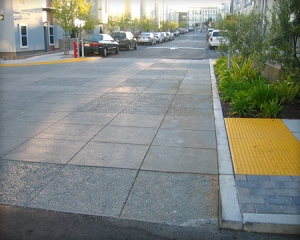Raised crosswalks bring the level of the roadway to that of the sidewalk, forcing vehicles to slow before passing over the crosswalk and providing a level pedestrian path of travel from curb to curb. Raised crosswalks can be located at intersections or mid block. At intersection locations, the raised area can be extended to include the entire intersection.
Process Overview
Raised crosswalks are typically installed as part of a traffic calming project or other public or private initiative. They are often installed when the City makes alleyway improvements at the intersection of an alley with a major street.
For raised crosswalks as part of the traffic calming process, see Traffic Calming Overview
Traffic calming devices require approval by an SFMTA hearing officer. Additionally, if the project would result in a change to certain parking or traffic designations, it may require approval by the SFMTA Board.
See Permit Process
Official Codes & Documents
- Better Streets Plan (street design guidelines)
- SFMTA Traffic Calming Guidelines
Design Guidelines
Street Types: Neighborhood Commercial; Neighborhood Residential; Boulevard (local lanes only); Alley; Shared Public Way
Sidewalk zones: Extension Zone; Roadway
Raised crosswalks should be considered:
- As a standard treatment at alleys and shared public ways
- Where low-volume streets intersect with high-volume streets, such as at alley entrances, neighborhood residential streets, and local access lanes of multi-way boulevards
- Where a street changes its function or street type. For example, a commercial throughway may become a neighborhood commercial or a residential street as the land uses along it change
- At key civic locations
Raised crosswalks should not be used on designated transit routes or where there are steep grades or sharp curves.
Raised crosswalks should:
- Be flush with the sidewalk in height, and at least the width of the crossing or intersection
- Be long enough in the direction of travel to allow both front and rear wheels of a passenger vehicle to be on top of the table at the same time – typically 10 feet. Specific lengths should be determined by using the ITE/FHWA document Traffic Calming: State of the Practice
- Be instituted in combination with special paving treatments as discussed above, or use the same material as that of adjacent sidewalks
- Provide detectable warnings where pedestrians will cross into the vehicle area
- Be designed such that the vertical transition does not cause unnecessary jarring or discomfort to vehicle passengers with spinal cord injuries when driven over at the appropriate speed
Consider resulting drainage patterns—depending on grade, this may necessitate additional catch basins, trench drains, or other measures
Maintenance
With some exceptions, fronting property owners are responsible for the on-going maintenance and upkeep of sidewalk paving as well as all sidewalk elements directly fronting their property, such as trees, landscaping, and streetscape furnishings. Generally, the City is responsible to maintain roadway paving and other features in the roadway, such as medians.
See Traffic Calming Overview: Maintenance.
For a more detailed description of maintenance responsibilities, see Maintenance







 Copyright © 2015
Copyright © 2015